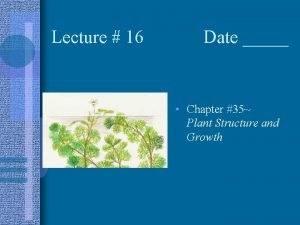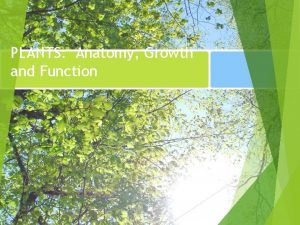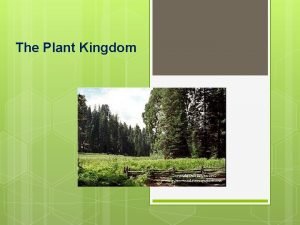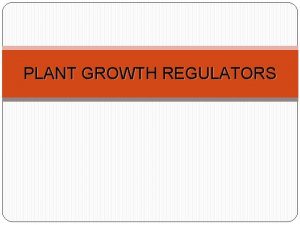PLANTS Anatomy Growth and Function Plant Characteristics Plants






- Slides: 6

PLANTS: Anatomy, Growth and Function

Plant Characteristics • Plants need energy, nutrients, water, gas exchange protection from herbivores and disease and to reproduce. • Photosynthesis: Carbon dioxide + water + sunlight -> glucose + oxygen • Glucose is a carbohydrate (made of C, H, and O). Carbs are used by plants to grow, maintain and develop. • Sexual and asexual reproduction.

Basic Tissue Types • Dermal tissues – – 2 types: epidermis and periderm Outermost cell layers Thick cell walls covered in waxy cuticle Protection against water loss, injury, disease • Vascular tissues – – – 2 types: xylem and phloem Xylem: thick walled cells, dead at maturity Phloem: thin walled cells, living at maturity Like tubes Transport water and nutrients

Basic Tissue Types • Ground Tissues – 3 types: • Parenchyma: thin-walled, living cells, support growth and development, stores carbs as starch. • Collenchyma: thick-walled living cells, support growth and development, supports and protects plant body. • Sclerenchyma: cells with lignin in cell wall, dead at maturity, supports and protects plant body • Meristematic Tissues – An area of actively dividing undifferentiated cells – Eventually develop into specialized cells

Monocots and Dicots • Angiosperms are the class of plants that produce flowers which can be further divided into monocots and dicots • Monocots include grains, grasses • Dicots include common plants like the daisy, tomato, maple • Names are based on the structure of their seeds: made of a seed coat, embryo, endosperm, seed leaf (called a cotyledon) • Monocots have one cotyledon, dicots have two. • Cotyledons in the dicots contain the nutrients that nourish the embryo as it develops. • In the monocots, the endosperm contains the nutrients

Dicots and Monocots











